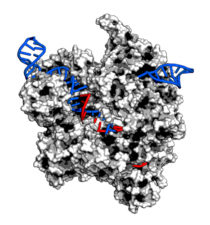 If you haven’t already heard of CRISPR-Cas9, you most definitely will soon. Almost every week there is another scientific/medical advance made using the CRISPR-Cas9 system.
If you haven’t already heard of CRISPR-Cas9, you most definitely will soon. Almost every week there is another scientific/medical advance made using the CRISPR-Cas9 system.
Just this week, scientists announced that they have used the technology to cut the HIV genome out of mice and rats, bringing us one step closer to a cure for HIV infection in humans. And this technology is not slowing down. On the contrary – it is progressing at an unprecedented speed.
Of course, we will continue to bring you news about all of the great ways in which CRISPR-Cas9 is being used in the future. However, before we talk about medical advances, we first need to understand how the CRISPR-Cas9 system works.
In order to do that, we have to think about bacteria.
The CRISPR-Cas9 system was first identified in bacteria where it is thought to act as the bacterial cell's “immune system.” Why do bacteria need an immune system, you might ask? Because, like us, bacteria can be infected and killed by viruses.
When a virus infects a bacterial cell (or any cell), its only job is to make more of itself (replication). Usually, in the process, it ends up killing its host cell - in this case, the bacterial cell. In order to replicate, the virus inserts its own DNA into the bacterial cell. However, the bacterium can tell that the viral DNA is not its own but belongs to a foreign invader. The CRISPR-Cas9 system allows the bacterium to destroy this viral DNA by cutting it up, “curing” the bacterium of the infection.
However, in some ways bacteria take their immunity one step further. The bacteria can not only try to fight off incoming viral infections as they are happening, they can also (1) keep a memory of their past infections and (2) pass on this memory/immunity to their offspring. This is analogous to my children being born immune to the flu because I had been infected with it at some point in my life before I had them.
The way that bacteria do this is kind of like how I carry around a ticket stub in my wallet in order to remember my first date with my husband – they keep a piece of the virus with them.
After the bacteria cut up the DNA of the infecting virus, they store small bits of that DNA together with their own DNA. They do this in a structured way, in which small chunks of viral DNA are separated by pieces of bacterial DNA. It is this signature of the system that is described by its name. CRISPR stands for “Clustered Regularly Interspaced Short Palindromic Repeats.”
Here is how the rest of the process goes.
- After the viral DNA is cut up and embedded into the bacterial DNA, the bacteria can then make strands of RNA (a closely related cousin to DNA - shown in red in the picture above) that are the same sequence as the viral DNA. These RNAs will be important for finding the viral DNA later on. That is why they are known as the "guide" RNA, because they help guide other players in this process to the correct DNA.
- These guide RNAs are bound by the protein Cas9 - a nuclease (a protein that can cut DNA - shown as the black and white structure in the picture above). Without the guide RNA, the Cas9 protein would meander aimlessly around the cell, without knowing which pieces of DNA to cut. However, the guide RNA instructs the Cas9 to bind to the DNA that matches its sequence (the viral DNA - shown in blue). The Cas9 protein then cuts the viral DNA (both strands). DNA that is cut is inactivated, and the virus cannot make more of itself.
So, why is CRISPR-Cas9 the hottest thing around?
In 2012, the process described above was modified to create a gene editing tool that directs the Cas9 nuclease anywhere in the genome simply by providing the guide RNA to the cell.
So, let’s say you have a history of Huntington’s Disease in your family. As a child, you undergo genetic testing and it turns out that you have a mutation in the HTT gene. This means that when you reach 30-40 years old, you will develop Huntington's Disease, a neurodegenerative condition with no cure. Huntington's causes progressive impairment of a person's physical and mental state. But, what if you could follow up with an appointment in which a CRISPR-Cas9 treatment cut out your mutated copy of the HTT gene and replaced it with the non-diseased copy of the gene, curing you of Huntington's Disease? This is, with the advent of the CRISPR-Cas9 system, not a far away dream. In fact, there are several biotech companies that are harnessing this technology to treat human disease.
Now that you know how it works, you can be aware of the advances and watch as this field continues to explode and potentially change medicine as we know it.



